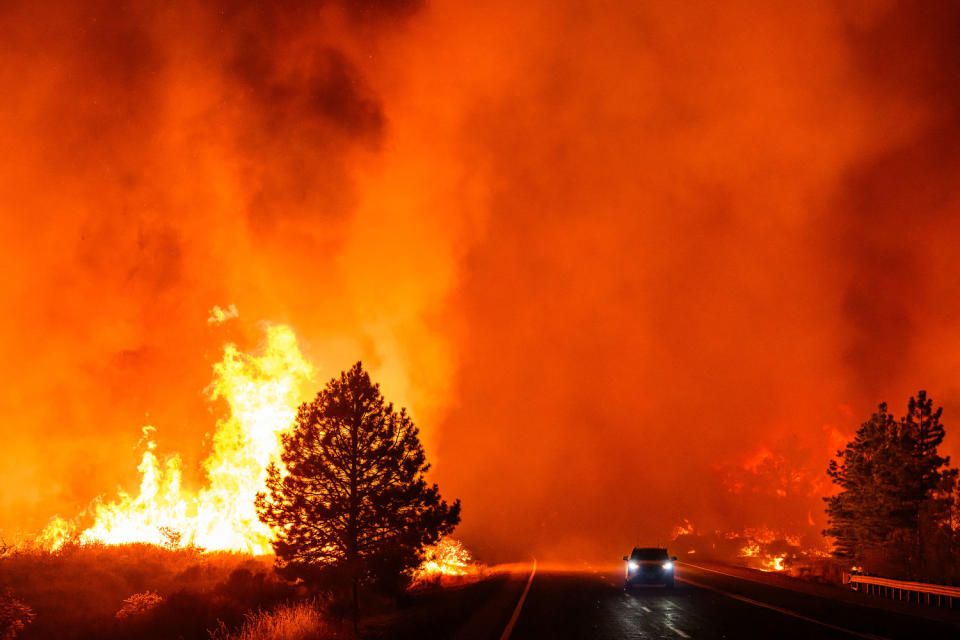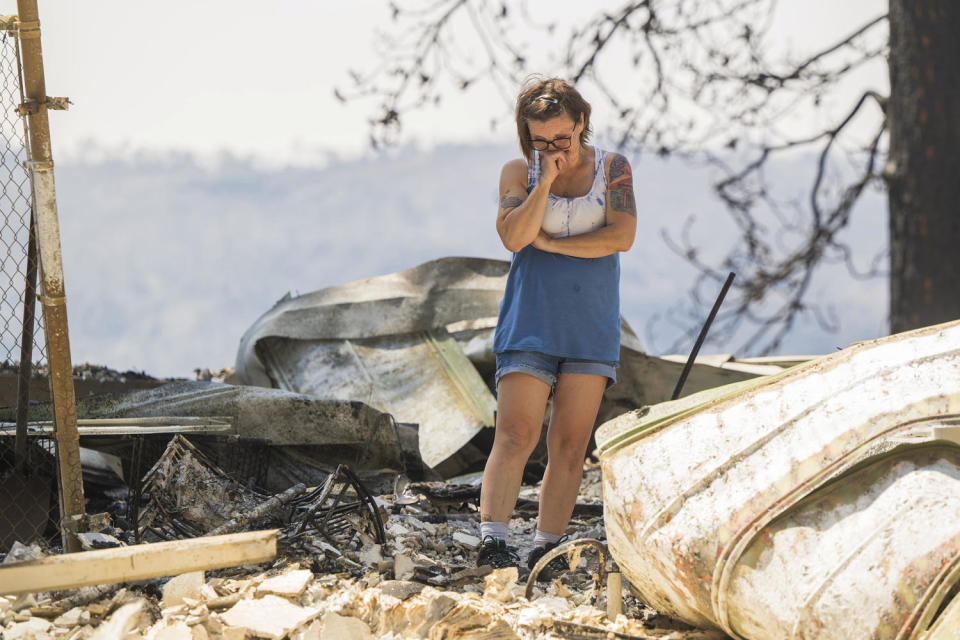On a hot Wednesday in July, Ronnie Dean Stout II stood next to a smoking Toyota Yaris near a swimming hole in Chico, California, and watched the flames grow, authorities allege. He made no move to put out the fire and then pushed the vehicle over a 60-foot embankment, according to a witness account in court documents.
The car rolled into a ravine full of dry vegetation, which the witness saw “explode” into flames, court documents say.
Temperatures that day were well over 100 degrees and it was windy – “red flag” conditions ripe for a fire. The fire moved at breakneck speed. In just 48 hours, the park fire had destroyed more than 130 buildings, burned 175,000 acres of land and forced thousands to evacuate, court papers said.
Stout denied pushing the car, the district attorney said, and he pleaded not guilty to the arson charge. A public defender representing Stout did not respond to a request for comment.
The Park Fire was the fourth largest in California history and burned 430,000 acres. It set a state record for acres burned in a suspected arson.
“We have never had a fire of this size caused by arson,” said Gianni Muschetto, the chief of police for the California Department of Forestry and Fire Protection. “This will be something of historical significance.”
In total, just over 1 million acres of California have burned so far this year, and nearly half of those were the result of fires allegedly set by arsonists, according to fire officials and an NBC News review of state incident data.


About 10 to 15% of wildfires in California are started by arson each year – and 2024 appears to be in line with that trend. However, as climate change causes temperatures to rise, fire seasons to lengthen and drought conditions to become more intense, intentionally started fires have more opportunities to spread and grow.
That has resulted in more than 477,000 acres burning due to suspected arson this year — by far the largest number since 2014, when 98,259 acres burned due to arson, according to Cal Fire.
Muschetto said fires started by arson posed the greatest risk if drought or other effects of climate change caused the wood to dry out.
“Then these fires are more likely to get bigger faster and damage or burn down homes – or hopefully not, but possibly – injuring or killing people who can’t escape because the fire ends up getting bigger and bigger,” he said.
Additionally, he added, California’s wildfire season is lasting longer than it used to. The state’s southeastern desert basin has added 61 additional fire weather days from 1973 to 2022, according to the nonprofit group Climate Central.
“It just means more opportunities to start wildfires year-round,” Muschetto said.
This week, parts of California were hit by a record-breaking October heat wave. Temperatures in the Los Angeles area away from the coast were expected to become “dangerously hot,” with temperatures reaching 105 degrees in some regions on Saturday, according to the National Weather Service.
Jeffrey Prestemon, a researcher at the U.S. Forest Service’s Southern Research Station in North Carolina, said arson also poses an acute risk because fires started this way tend to cause more damage per acre than fires caused by lightning or other factors.
“They are often placed where … people live, where there are structures,” Prestemon said.
Given that, he said, “an arrest can be a big win.”
Prestemon has studied wildfires in Florida, Spain and other places. He and other researchers found in a study that the arrest of a single arsonist in a particular region of Spain was associated with a decrease in nearly 140 wildfire outbreaks in that region the following year.
“What we suspect: It’s primarily a serial effect, where one person sets multiple fires over a short period of time, usually spanning several days, a week or two weeks,” Prestemon said. “If they don’t get caught, they will repeat this type of serial episode.”
Prestemon added that arrests could deter other arsonists.
This year in California, Cal Fire had arrested 91 people on suspicion of arson through the end of August, Muschetto said. The number appears to follow normal trends.
Wildfire arson is not well studied, but researchers in the United States, Europe and Australia have narrowed down the profile of typical perpetrators. Forest fire arsonists are usually men, often young people. Many set multiple fires.
“Repeated fires are common,” said Janet Stanley, an honorary professor at the University of Melbourne in Australia. “People who, for whatever reason, feel a psychological need around a fire do it many times, and often they don’t get caught until they’ve done it multiple times.”
In California, Muschetto attributed fluctuations in wildfire arson rates to the fire danger and likelihood of fire in the landscape.
Cal Fire has counted between 182 and 386 arson incidents each year since 2014, with rates remaining roughly consistent relative to the total number of fires. However, the actual number of fires caused by arson is likely higher than the official number because investigators cannot always determine how a fire started. The causes of more than 320 fires in 2023 remain unknown.
For similar reasons, wildfire arson cases can also be difficult to prosecute, experts say. Compared to urban arsons, these crimes often provide less physical evidence, said Daniel Fox, a prosecutor in the Riverside County District Attorney’s Office who has handled wildfire arson cases.
“When it comes to wild land, it takes a lot less time to get the fire going and get it monstrous than if I wanted to burn down a car or the side of a house,” Fox said.
That’s especially true in rural parts of his county, Fox added, where the landscape is so dry that even a sideways glance at the grass “could cause it to burst into flames,” he joked.
Muschetto said Cal Fire investigators are trained to identify wildfire patterns and the point of origin of a fire, then look for remnants of an ignition source.
“It could be something as small as a match head, that’s all that’s left. “You may not find anything if it is completely destroyed in a fire,” Muschetto said.
This can lead to investigators relying on witness reports and circumstantial evidence. Muschetto said the increasing use of surveillance cameras, smartphones and satellite tracking devices in rural areas has helped Cal Fire solve more cases over the past 10 or 20 years.
But even when cases go well for prosecutors, victims of arson-caused wildfires rarely go unharmed, Fox said.
He led the prosecution of Brandon McGlover, who started multiple fires that led to the 2018 Cranston Fire, which burned more than 13,000 acres near Idyllwild, California and destroyed several homes.
Investigators were able to link McGlover’s plausible movements to several fires that day, Fox said. They had eyewitness testimony linking McGlover’s car to an area where a fire broke out, traffic camera video, security video and cans of WD-40 discovered in his car.
Prosecutors reached a deal and McGlover was sentenced to more than 12 years in prison and ordered to pay restitution to the victims. But Fox said it’s unlikely that the people who lost property will have their entire losses covered by insurance or reimbursement.
“The reality is that there is no real mechanism to compensate them,” Fox said. “His name was neither Bezos nor Rockefeller and he went to prison for a long time.”


Stout, the suspect in the park fire, was arrested on July 25, the day after the fire broke out, and charged with “arson of an inhabited building or grounds.” If convicted, he faces 25 years to life in state prison.
Butte County District Attorney Mike Ramsey said in an email that Stout said the witness account of his alleged actions was false.
Stout is being held in the Butte County Jail while he awaits trial. His next court date is Oct. 17, when a preliminary hearing date is expected to be set.
This article was originally published on NBCNews.com


